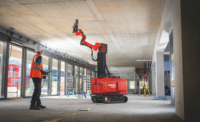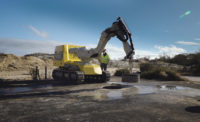Within days of the earthquake and tsunami that severely damaged Japan's Fukushima Daiichi nuclear plant, Tokyo Electric Power Co. and the Japanese government were in talks with equipment manufacturers about how their specialized machines could lend a hand. Cargo planes airlifted huge concrete pumps to water-cool the reactors, and a robotics manufacturer known primarily as a defense contractor stepped forward with an unusual proposal.
“We had contacted TEPCO, and after a demonstration of our equipment they chose to deploy it to the site,” says Ed Godere, senior vice president, unmanned systems, QinetiQ North America, Reston, Va. QinetiQ manufactures compact, remotely operated robots for the military, bomb squads and first responders. The firm makes a Bobcat loader conversion kit that allows for total remote operation. “There is a large amount of debris from the hydrogen explosion and the tsunami. [The debris] may be contaminated. These machines will be used for site cleanup,” said Godere. The kit sells for $50,000 to $80,000, depending on the options.
“The kit will fit any Bobcat loader [skid-steer, compact-track or all-wheel-steer models] equipped with selectable joystick control. It's all magnet-mounted and installs in about 15 minutes,” says Mike Melroe, government sales group manager for Bobcat Co., West Fargo, N.D. “We sent over two T300s with 80-inch industrial grapples. All equipment was shipped in about a week to Japan.” QinetiQ's nimble Talon and Dragon robots will work in concert with the Bobcat loaders, which have the muscle to clear paths or act as “marsupials,” carrying the smaller robots to the reactor buildings in their buckets. All the remotely operated machines have real-time streaming video and are equipped with radiation and temperature sensors.
“We sent a team to Japan and trained 16 TEPCO employees,” says Godere. “We had several control options, including a [Microsoft] Xbox controller. People show a lot of familiarity with it, and it helps accelerate training.” The machines are radio-controlled, with a half-mile range for the smaller robots and up to one mile for the Bobcats. Bobcat usually would sell T-300s and their attachments for about $75,000 each, but the company is donating the equipment for the cleanup.
QinetiQ estimates its expenditure at roughly $1 million, factoring in equipment, shipping and staff.
Getting a closer look at the damaged reactors is only part of the solution. Once the cooling system failed at the Fukushima plant, the intense heat of the fuel led to a series of hydrogen explosions that tore open the reactor buildings and damaged containment vessels.
Powerplant operators' immediate concern was to cool the radioactive fuel. Hiroshi Suzuki, director of Putzmeister Japan, Tokyo, saw an opportunity to help. He contacted TEPCO and the office of the president of Japan.
Putzmeister redirected to Japan a 58-meter M58-5 truck-mounted concrete pump intended for a customer in Southeast Asia. It arrived on March 21 and was pumping seawater onto the crippled No. 4 reactor the next day. The pump has an output of 160 cu m per hour at a pressure of 85 bar, and it is powered by the truck's diesel engine. The boom's multiple joints allow it to get over the building's walls and place seawater as accurately as concrete.
Putzmeister America President Dave Adams flew to Japan from Atlanta on April 9 with two 70-m Putzmeister 70C concrete pumps, normally only available in North America.
“Our thoughts have been with the people of Japan as they deal with this unprecedented crisis,” Adams said in a press statement. “Fortunately, we have a piece of equipment that is working to help cool Japan's nuclear reactors, so we're moving full speed ahead to get additional pumps to Japan to help sustain the effort.”
Four more pumps are set to arrive in Japan this week, says Kelly Blickle, marketing manager for Sturtevant, Wis.-based Putzmeister America. “We decided to put new parts in and do a full maintenance update on the machines,” she says. “Brand new, these machines would go for about $2 million apiece, but TEPCO is purchasing them at a reduced price as they are not new.”
There are only three manufacturers that make concrete pumps with booms longer than 56 m: Putzmeister, Aichtal, Germany; SANY Heavy Industry Corp., Changsha, China; and Schwing, Heerstra�e, Germany. TEPCO sought to purchase a 62-m SANY SY5502THB truck-mounted concrete pump following the disaster, but SANY President Liang Wengen offered the unit free of charge.
The pumps may end up serving a dual use. “We're helping to cool the reactors, but the pumps may also be used for concrete if they decided to entomb the reactors, like at Chernobyl,” Blickle says.










Post a comment to this article
Report Abusive Comment